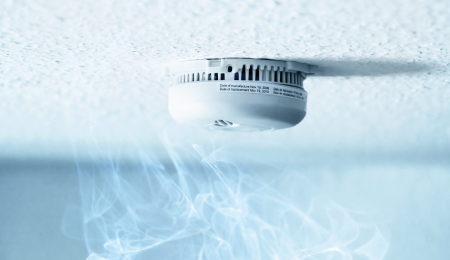3 Steps to a Fire-Ready Home
September is National Preparedness Month, and this year, we’re focusing on fire preparedness. By carefully planning for the worst and installing or upgrading your home’s fire safety features, you can be prepared for anything. Here are some tips to help you get started.
Plan, Prepare, and Practice
There is no better time than during Preparedness Month to come up with a fire safety plan for your home and family. Take this time to devise a fire safety plan and then practice, practice, practice.
Plan and Prepare
 Have you ever thought about what you would do if a fire threatened your home? Your best line of defense is to come up with a thorough fire safety plan. Take a walk through your entire house and make note of all possible exits. Choose the safest escape route as the primary plan, but write down all other routes as backups. If you have a two-story home, it may be wise to invest in an escape ladder.
Have you ever thought about what you would do if a fire threatened your home? Your best line of defense is to come up with a thorough fire safety plan. Take a walk through your entire house and make note of all possible exits. Choose the safest escape route as the primary plan, but write down all other routes as backups. If you have a two-story home, it may be wise to invest in an escape ladder.
You’ll also want to designate a safe meeting place in your neighborhood for everyone to gather after getting out of the house. And remind everyone in your family that once they are out, there is no going back in. When the firefighters arrive, they will have the right equipment and skills to rescue any people or pets.
Getting out of the house safely is the most important part of the plan, but you’ll also want to consider where you would go if you and your family were displaced by a fire. You may want to contact a local family member or speak to your homeowner’s insurance agent about possible accommodations.
Practice
Once you’ve chosen the safest escape route, it’s time to practice. Everyone—especially children—should practice the fire escape plan at least twice per year. Remember those fire drills you used to have in school? They weren’t just an excuse to take a break in the middle of the day. They were to make sure students and teachers were prepared for an emergency.
Try to make your practice drills as realistic as possible. If you’ve bought an escape ladder, practice using the ladder according to its instructions out of a first-floor window first. Make sure that your children and any other household members practice setting up the ladder and using it safely. You’ll also want to practice getting low to escape under the smoke. Since heat and smoke rise, you’ll be safest from the toxic smoke when you’re lower to the ground.
Install Fire Safety Features
National Preparedness Month may be the best time to install or inspect fire safety features in your home. The first step should be to make sure all of your smoke detectors are working. You should be testing your smoke detectors at least once a month and changing the batteries at least once per year.
You may also want to consider installing water sprinklers in your home for reinforcement. However, you must make sure to install the proper water flow switches to monitor water flow and pressure. Fire damage can be bad enough on its own. You don’t want to add flood damage to the problem.
Upgrade Your Home Alarm System
While smoke detectors will alert you of a fire threat, a fire alarm will go one step further. In the event of smoke or a fire, your fire alarm will automatically send an alert to your home monitoring center. They will ensure that the fire department gets sent to your home right away. Should a fire affect your home while you are away, your fire alarm can help save you from destruction.
As an added bonus, if you have a fire alarm as part of your home security system, your homeowner’s insurance may offer a discount. Be sure to contact your provider if you have one installed or are planning an upgrade.


